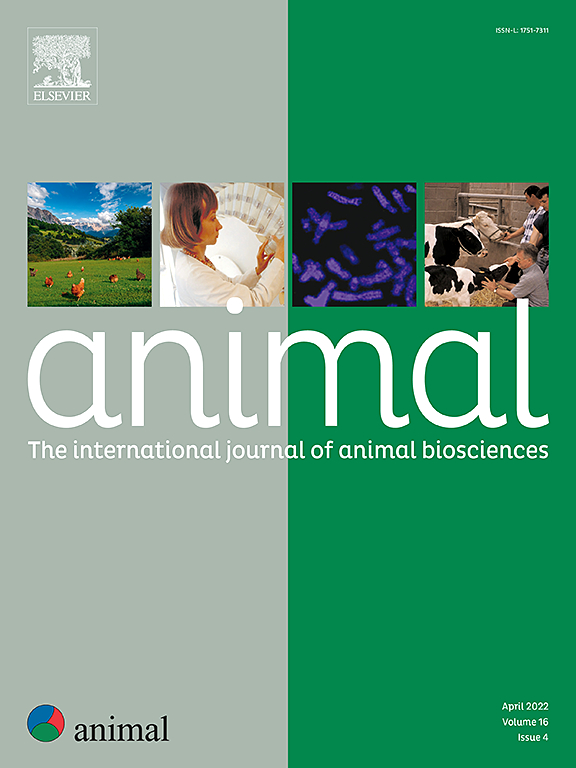基于繁殖性状的母猪抗逆性全基因组关联研究及基因组预测
IF 4.2
2区 农林科学
Q1 AGRICULTURE, DAIRY & ANIMAL SCIENCE
引用次数: 0
摘要
健壮的动物通常不易感染疾病,需要的药物也较少,因此具有更强的适应力。随着大数据收集技术的进步,通过检查纵向数据来发现新的弹性指标已经成为可能。环境因素引起的生殖性状变异可能影响动物适应环境变化的能力。然而,没有发表的研究使用繁殖性状的变化来评估猪的恢复能力。本文收集了11 321头约克郡母猪、3 317头长白母猪和1 745头杜洛克母猪的生殖性状资料。对于生殖性状,我们计算了每个环境标准偏差(SDe)作为它们的弹性。3个品种间弹性性状的遗传率在0.02 ~ 0.61之间。共对9 171头母猪进行了基因分型试验,采用KPS®中原-1猪育种芯片ChipV2(1 133头约克郡、176头长白猪和116头杜洛克母猪)、Chip_plus(2 815头约克郡、1 017头长白猪和663头杜洛克母猪)和CAU50K(2 287头约克郡、614头长白猪和350头杜洛克母猪)。经质量控制后,共有46 358个单核苷酸多态性(snp)和9 171个个体用于后续的全基因组关联研究(GWAS)和基因组选择预测。通过对3个品种生殖性状SDe的GWAS分析,共发现130个显著snp和3 259个候选基因。利用BLUP对各生殖性状的SDe进行了育种值估计信度分析,信度范围为0.05 ~ 0.49。当使用基因组BLUP (GBLUP)和单步GBLUP (ssGBLUP)时,约克郡和杜洛克母猪的平均基因组预测可靠性分别提高了0.02(范围:−0.02 ~ 0.09)和0.04(范围:−0.01 ~ 0.08)。10个生殖性状及其原始性状的SDe表现为表型相关(|0.01| ~ |0.90|)和遗传相关(|0.00| ~ |0.99|)。综上所述,窝重SDe和存活率SDe可作为3个品种恢复力的指标。此外,产母数SDe、出生虚弱数SDe和死产数SDe可作为约克郡和杜洛克母猪的弹性性状,而出生健康数SDe可用于长白母猪的弹性进化。在三个品种的繁殖方面,高适应力个体的表现优于低适应力个体。这些发现奠定了将恢复力纳入育种程序的基础,也扩大了用于评估母猪繁殖潜力和抗病能力的分子标记的范围。本文章由计算机程序翻译,如有差异,请以英文原文为准。
Genome−wide association study and genomic prediction of sow resilience based on reproductive traits
Robust animals, which are generally less susceptible to disease and require fewer medications, have greater resilience. As big data collection technologies have progressed, discovering new indicators of resilience by examining longitudinal data has become feasible. Environmental factor-induced variability in reproductive traits may affect an animal’s ability to adjust to changing environmental circumstances. However, no published research has used variations in reproductive traits to assess pig resilience. We here gathered data on reproductive traits of 11 321 Yorkshire, 3 317 Landrace, and 1 745 Duroc sows. Regarding reproductive traits, we computed each environmental standard deviation () as their resiliencies. The heritability of resilience traits ranged from 0.02 to 0.61 across three breeds. In total, 9 171 sows were conducted genotyping with three chips, namely, KPS® Zhongxin-1 Porcine Breeding ChipV2 (1 133 Yorkshire, 176 Landrace, and 116 Duroc sows), Chip_plus (2 815 Yorkshire, 1 017 Landrace, and 663 Duroc sows), and CAU50K (2 287 Yorkshire, 614 Landrace, and 350 Duroc sows). After quality control, 46 358 single−nucleotide polymorphisms (SNPs) and 9 171 individuals were used for the subsequent genome-wide association study (GWAS) and genomic selection prediction. A total of 130 significant SNPs and 3 259 candidate genes were found through GWAS on of reproductive traits across three breeds. Using BLUP, we performed breeding value estimation reliability for of reproductive traits and revealed that the reliability varied from 0.05 to 0.49. When genomic BLUP (GBLUP) and single-step GBLUP (ssGBLUP) were used, the average genomic prediction reliability increased by 0.02 (range: −0.02 to 0.09) and 0.04 (range: −0.01 to 0.08) for Yorkshire and Duroc sows, respectively. For of ten reproductive traits and their original traits, the phenotypic correlations (|0.01| to |0.90|) and genetic correlations (|0.00| to |0.99|) were observed. Considering results comprehensively, of litter weight and of survival rate could be used as indicators of resilience for all three breeds. Furthermore, of number of mummies, of number born weak, and of number of stillbirth could be as resilience traits for Yorkshire and Duroc sows, and of number of born healthy could be used for resilience evolution in Landrace sows. High-resilience individuals outperformed low-resilience counterparts in terms of reproduction across three breeds. The foundation for integrating resilience into breeding procedures was established by these findings, which also broadened the range of molecular markers used to evaluate sow reproductive potential and disease resistance.
求助全文
通过发布文献求助,成功后即可免费获取论文全文。
去求助
来源期刊

Animal
农林科学-奶制品与动物科学
CiteScore
7.50
自引率
2.80%
发文量
246
审稿时长
3 months
期刊介绍:
Editorial board
animal attracts the best research in animal biology and animal systems from across the spectrum of the agricultural, biomedical, and environmental sciences. It is the central element in an exciting collaboration between the British Society of Animal Science (BSAS), Institut National de la Recherche Agronomique (INRA) and the European Federation of Animal Science (EAAP) and represents a merging of three scientific journals: Animal Science; Animal Research; Reproduction, Nutrition, Development. animal publishes original cutting-edge research, ''hot'' topics and horizon-scanning reviews on animal-related aspects of the life sciences at the molecular, cellular, organ, whole animal and production system levels. The main subject areas include: breeding and genetics; nutrition; physiology and functional biology of systems; behaviour, health and welfare; farming systems, environmental impact and climate change; product quality, human health and well-being. Animal models and papers dealing with the integration of research between these topics and their impact on the environment and people are particularly welcome.
 求助内容:
求助内容: 应助结果提醒方式:
应助结果提醒方式:


